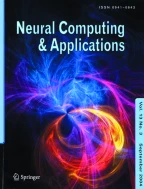Abstract
Double inverted pendulum on a cart (DIPC) is a highly nonlinear system. Due to its complex dynamics, it is widely used as a test-bed plant for the verification of newly designed controllers. In DIPC, two pendulums are kept upward by linear movements of cart. Because of this linear motions and frequent switching of velocity directions, another nonlinearity caused by friction becomes dominant around the equilibrium point. Friction introduces limit cycles to the system and results in a poor steady-state response. To eliminate these negative effects, the locally linear neuro-fuzzy (LLNF) approach is used to build an inverse model for friction compensation. This model is compared with multilayer perceptron network in order to demonstrate the better performance of LLNF. To stabilize DIPC, a common optimal controller is used, and despite its limited performance, experimental results show that the application of inverse modeling for friction compensation improves the steady-state response outstandingly.
Similar content being viewed by others
Explore related subjects
Discover the latest articles, news and stories from top researchers in related subjects.Abbreviations
- DIPC:
-
Double inverted pendulum
- LLNF:
-
Locally linear neuro-fuzzy
- LOLIMOT:
-
Locally linear model tree
- MLP:
-
Multilayer perceptron
References
Olsson H, Åström KJ (2001) Friction generated limit cycles. IEEE Trans Control Syst Technol 9(4):629–636. doi:10.1109/87.930974
Park D, Chwa D, HongWadsworth S (2006) An estimation and compensation of the friction in an inverted pendulum. In: SICE-ICASE international joint conference, October, Bexco, Busan, Korea. doi:10.1109/SICE.2006.315273
Armstrong B (1988) Friction: experimental determination, modeling and compensation. In: Proceedings of the IEEE international conference on robotics and automation, Philadelphia, PA
Rizos DD, Fassois SD (2009) Friction identification based upon the LuGre and Maxwell slip models. IEEE Trans Control Syst Technol 17(1):153–160
Teeter JT, Chow Mo-yuen, Brickley JJ Jr (1996) A novel fuzzy friction compensation approach to improve the performance of a Dc motor control system. IEEE Trans Ind Electron 43(1):113–120
Huang SN, Tan KK, Lee TH (2000) Adaptive friction compensation using neural network approximations. IEEE Trans Syst Man Cybern C Appl Rev 30(4):551–557
Wang Y, Wang D, Chai T (2011) Extraction and adaptation of fuzzy rules for friction modeling and control compensation. IEEE Trans Fuzzy Syst (99):1. doi:10.1109/TFUZZ.2011.2134104
Canudas de Wit C, Noël P, Aubin A, Brogliato B (1991) Adaptive friction compensation in robot manipulators: low velocities. Int J Robot Res 10(3):189–199
Hornik K, Stinchcommbe M, White H (1989) Multilayer feed forward networks are universal approximators. Neural Netw 2:359–366
Selmic RR, Lewis FL (2002) Neural-network approximation of piecewise continuous functions: application to friction compensation. IEEE Trans Neural Netw 13(3):745–751. doi:10.1109/TNN.2002.1000141
Makaremi I, Fatehi A, Araabi NN, Azizi M, Cheloeian A (2009) Abnormal condition detection in a cement rotary kiln with system identification methods. J Process Control 19(9):1538–1545. doi:10.1016/j.jprocont.2009.07.013
Hafner M, Schuler M, Nelles O, Isermann R (2000) Fast neural networks for diesel engine control design. Control Eng Pract 8(11):1211–1221. doi:10.1016/S0967-0661(00)00057-5
Halfmann C, Nelles O, Holzmann H (1999) Modeling and identification of the vehicle suspension characteristics using local linear model trees. In: Proceedings of the IEEE international conference on control application and IEEE international symposium on computer aided control system design, Kohala Coast, HI, August
Koushki AR, Maraloo MN, Lucas C, Kalhor A (2009) Application of neuro-fuzzy models in short term electricity load forecast. Int CSI Comput Conf, article number 5349434, pp 41–46
Jalili-kharaajoo M, Ranji R, Bagherzadeh H (2003) Predictive control of a fossil power plant based on locally linear model tree (LOLIMOT). In: Proceedings of the IEEE conference on control application, Istanbul, June, vol 1, pp 633–638
Nelles O (2001) Nonlinear system identification. Springer, Berlin
Bogdanov A (2004) Optimal control of a double inverted pendulum on cart technical report, CSE-04-006
Fang L, Chen WJ, Cheang SU (2001) Friction compensation for a double inverted pendulum. In: Proceedings of the IEEE international conference on control application, Mexico City, September, pp 908–913
Zhong W, Rock H (2001) Energy and passivity based control of the double inverted pendulum on a cart. In: Proceedings of the IEEE international conference on control application, Mexico City, September, pp 896–901
Zurada JM (1992) Introduction to artificial neural systems. West Publishing Company, St. Paul, pp 175–235
Johansen TA, Foss BA (1995) Identification of non-linear system structure and parameters using regime decomposition. Automatica 31(2):321–326
Murray-Smith R, Johansen TA (1995) Local learning in local model networks. In: Proceedings of the international conference on artificial neural networks, Cambridge, UK, June
Author information
Authors and Affiliations
Corresponding author
Rights and permissions
About this article
Cite this article
Nejadfard, A., Yazdanpanah, M.J. & Hassanzadeh, I. Friction compensation of double inverted pendulum on a cart using locally linear neuro-fuzzy model. Neural Comput & Applic 22, 337–347 (2013). https://doi.org/10.1007/s00521-011-0686-3
Received:
Accepted:
Published:
Issue Date:
DOI: https://doi.org/10.1007/s00521-011-0686-3
